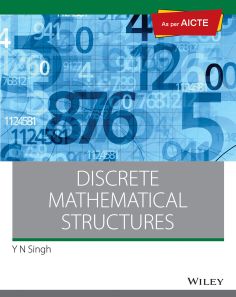Discrete Mathematical Structures, As per AICTE
ISBN: 9788126511952
364 pages
Publication Year: 2019
For more information write to us at: acadmktg@wiley.com

Description
The purpose of the subject Discrete Mathematical Structures is to develop the understanding of theoretical foundations of Computer Science. The emphasis is given on the applications of discrete structures in computer science. Discrete structures include important material from areas such as Set Theory, Proving Methods, Algebraic Structures, Logic, Graphs, Trees, Recurrences and Combinatorics.
Chapter 1 Set Theory
1.1 Introduction
1.2 Empty Set
1.3 Size of Sets and Cardinals
1.4 Venn Diagram
1.5 Subsets
1.6 Combinations of Sets
1.7 Multisets
1.8 Ordered Pairs
1.9 Set Identities
Chapter 2 Relations
2.1 Introduction
2.2 Properties of Relations
2.3 Representation of Relations
2.4 Composite Relations
2.5 Order of Relations
Chapter 3 Functions
3.1 Introduction
3.2 Classification of Functions
3.3 Operations on Functions
3.4 Recursively Defined Functions
Chapter 4 Natural Numbers
4.1 Introduction
4.2 Mathematical Induction
4.3 Induction Examples
4.4 Variants of Induction
Chapter 5 Algebraic Structures
5.1 Introduction
5.2 Groups
5.3 Subgroups and Order
5.4 Cyclic Groups
5.5 Cosets
5.6 Normal Subgroups
5.7 Permutation and Symmetric Groups
5.8 Group Homomorphisms
5.9 Rings
5.10 Fields
5.11 Integers Modulo n
Chapter 6 Lattices
6.1 Introduction
6.2 Partial Order Sets
6.3 Preorder
6.4 Combinations of Partial Order Sets
6.5 Hasse Diagram
6.6 Bounds
6.7 Lattices
6.8 Properties of Lattices
6.9 Morphisms of Lattices
Chapter 7 Boolean Algebra
7.1 Introduction
7.2 Boolean Operators and Precedence
7.3 Axiomatics of Boolean Algebra
7.4 Theorems of Boolean Algebra
7.5 Boolean Expressions and Functions
7.6 Algebraic Manipulation of Boolean Expressions
7.7 Simplification of Boolean Functions
7.8 Logic Gates
7.9 Digital Circuits and Boolean Algebra
7.10 Combinational Circuits
7.11 Sequential Circuits
Chapter 8 Propositional Logic
8.1 Introduction
8.2 Sentences
8.3 Statements
8.4 Propositional Logic
8.5 Theory of Inference
8.6 Natural Deduction
8.7 Predicate Logic
Chapter 9 Trees
9.1 Binary Trees
9.2 Binary Tree Representation
9.3 Binary Tree Traversal
9.4 Evaluation of Binary Expression Trees
9.5 Binary Search Trees
Chapter 10 Graphs
10.1 Paths and Cycles
10.2 Connectivity
10.3 Subgraph
10.4 Contraction and Minors
10.5 Degree of a Vertex
10.6 Regular Graph
10.7 Representation of Graphs
10.8 Bipartite Graphs
10.9 Planar Graphs
10.10 Isomorphism and Homeomorphism of Graphs
10.11 Multigraph
10.12 Euler Paths
10.13 Hamiltonian Paths
10.14 Graph Coloring
Chapter 11 Recurrence Relations
11.1 Linear Recurrences
11.2 Inhomogeneous Recurrences
11.3 Growth of Functions
11.4 Recurrences from Algorithms
Chapter 12 Generating Functions
12.1 Generation Functions
12.2 Generating Functions for Recurrences
12.3 Operations on Generating Functions
12.4 Generating Functions and Combinatorics
12.5 Useful Power Series
Chapter 13 Combinatorics
13.1 Counting Techniques
13.2 Pigeonhole Principle
13.3 Pólya's Counting Theory
Exercises

